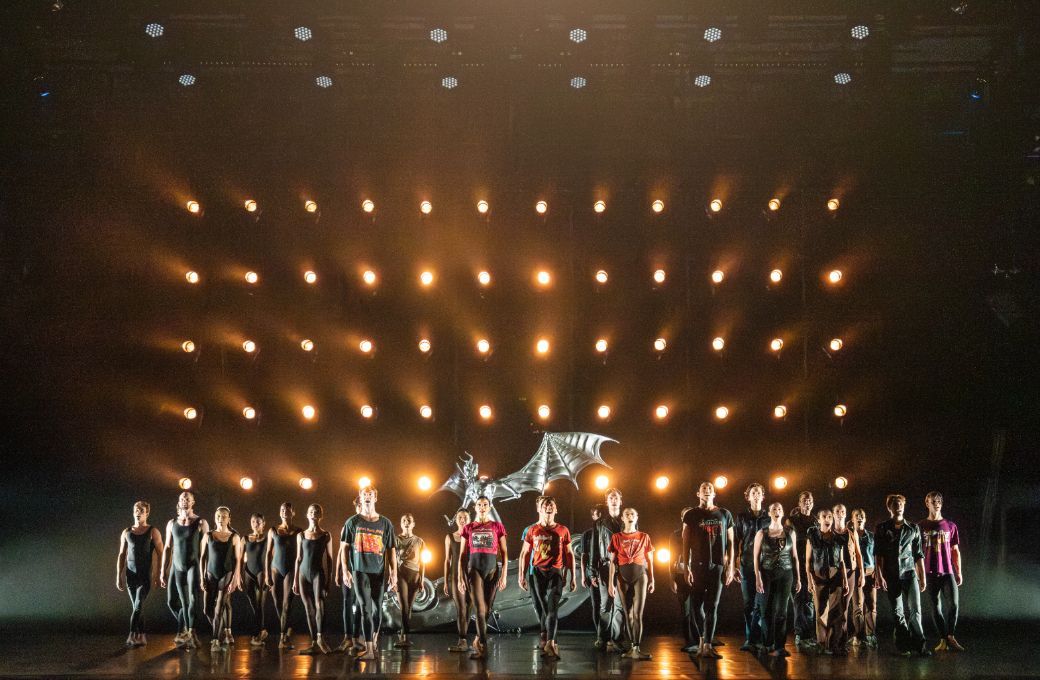The torrential rainfall that had water gushing down the gutters outside Sadler’s Wells seemed in empathy with this Brummie takeover of London’s main dance venue, represented by the integrated cultural icons of Black Sabbath and Birmingham Royal Ballet.

Black Sabbath – The Ballet is one of several recent attempts to set dance to music of a particular band or artist. We’ve had Quadrophenia, Message in a Bottle and soon to come will be a ballet to the music of James Brown. But this Birmingham-based hybrid has a unique appeal in setting classical ballet to an arrangement of heavy metal, and – on this occasion although not at all performances – elevated by the live performance of Tony Iommi, the legendary guitarist widely proclaimed as the godfather of heavy metal.
Although the Black Sabbath heydays were during my youth, I confess to not having been a fan. But better late than never and this mix of recorded songs (War Pigs is my new favourite) and the live orchestral arrangement of early Black Sabbath music, conducted by the lead composer, Christopher Austin, brought just the right balance between ballet and rock to recruit this Johnny-come-lately.
Each act of this abstract triple bill has been created by closely connected but discrete teams. The opener, choreographed by Raúl Reinoso and composed by Marko Nyberg and Austin, featured the onstage guitarist, Marc Hayward, mingling with a cast in which Yaoqian Shang and Javier Rojas shared the longest continuous kiss in the ballet repertoire. Their lips remained seemingly glued together throughout a seamless pas de deux of several minutes’ duration; so long, and so sensuously combined, that I felt tempted to yell “get a room”!
The second act, choreographed by Cassi Abranches and composed by Sun Keting, involved a different section of the ensemble and was performed against an intriguing “documentary podcast” featuring various anecdotal reminiscences of the band, plus interjected comments from Sharon Osbourne. Poignantly, this revival comes after the death of her husband, Ozzie, whose voice remains a testament to the chaos of those early years. “Our cocaine bill was more than our recording bill and our recording bill was £80,000,” declared Ozzie, while also admitting that they regularly dismantled hotel bathrooms!
Iommi talked matter-of-factly about being told he would never play guitar again after the tops of two fingers in his fret-playing hand were guillotined in a factory accident. He proved the doctors wrong by creating new fingertips out of moulded plastic (from washing-up liquid bottles) and cut-offs from an old leather jacket; and changing his technique to accommodate the structure of his new hand, which became the lower-pitched basis for the band’s reinvention of heavy metal.
The final act, choreographed by Pontus Lidberg and composed by Austin, united the ensemble with the return of Hayward’s exuberant, itinerant guitar-playing and the stage opened out to see into the wings. The action was dominated by an upturned silver automobile on top of which stood the silver statue of a winged demon, compete with horns and tail. Although large, this artefact was clearly lightweight and on castors since the dancers moved it easily (and somewhat aimlessly) around the stage.
Each act had a boisterous and uplifting ensemble finish with dancers racing through complex choreography in a breathless finale, utilising tight turns and fast spins, multiple lifts and synchronised movement of largely pinpoint unity. There was a leitmotif of backward steps, sometimes accompanied by a shrug or with reverse kicks and an impressive burst of group fouettés, interestingly contrasting the left and right turners. The dancers’ zestful enjoyment was evident throughout, transmitting similar emotions to the audience who were mostly on their feet by the end.
In that final act, the commanding presence of Lucy Waine and Lachlan Monaghan contrasted with the silky elegance of Momoko Hirata. Monaghan also demonstrated a talent for singing. Other noteworthy soloists were Tzu-Chao Chou, Céline Gittens, Haoliang Feng and Riko Ito and I was impressed by Ava May Llewellyn; a dancer new to me.
Alexandre Arrechea’s set design was dominated by Black Sabbath symbolism, not only in that upturned silver car and devil but also in what seemed like giant casino chips, lowered and raised from time-to-time and featuring imagery like a crucifix, boots, a peace symbol and what appeared to be a wig.
The evening was made all-the-more special by Iommi’s appearance, which – in a first for my experience – had all the stage crew visibly lined up in the wings to watch as this legendary guitarist performed both a solo and duet with Hayward, like master and pupil.
The choreography, music and performance made this an impressive event, but Iommi’s cameo was an emphatic cherry on the top that sent the crowd home (Sabbath and ballet fans alike) with an enthusiastic spring in their step, despite that torrential rain.


